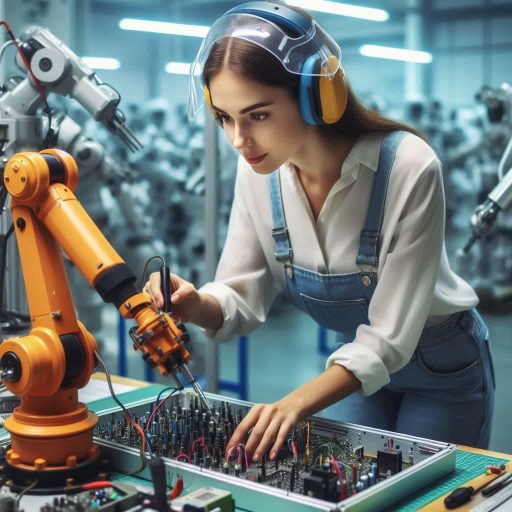Introduction
Robotics engineering has become a cornerstone of modern society, revolutionizing various fields from manufacturing to healthcare.
Robots streamline production processes, enhance precision in surgeries, and even assist in everyday tasks, making life easier and more efficient.
The impact of robotics is profound, contributing to significant advancements in technology and offering new solutions to complex problems.
Despite these benefits, the rise of robotics engineering brings important ethical and legal considerations.
As robots become more integrated into our daily lives, concerns about privacy and data security grow.
Robots often collect vast amounts of data through sensors and cameras, raising questions about how this data is stored, used, and protected.
The potential for misuse or unauthorized access to this information poses significant risks to individuals’ privacy.
Moreover, the automation of jobs through robotics can lead to substantial economic and social implications.
As robots take over tasks traditionally performed by humans, there is a growing concern about job displacement.
Workers in various industries may face unemployment or the need for retraining to adapt to new roles.
Addressing these challenges requires careful planning and policy development to ensure a smooth transition and support affected workers.
Legal issues surrounding robotics are also complex.
Determining liability for accidents involving robots can be difficult.
The Role of Government Regulations in Robotics Engineering
The Need for Government Oversight in Ensuring Safety and Ethics in Robotics Engineering
Government oversight is essential in robotics engineering to ensure both safety and ethical practices.
As robots become increasingly integrated into various sectors, regulations are needed to address potential risks and ethical dilemmas.
This oversight helps prevent accidents, ensures robots operate safely, and addresses concerns related to privacy and autonomy.
Effective regulation helps protect public safety by enforcing standards that require rigorous testing and certification processes.
These standards ensure that robots meet safety requirements and function reliably, minimizing the risk of injury or malfunction.
Moreover, regulations help address ethical issues, such as how robots make decisions and handle personal data, ensuring that advanced technologies are used responsibly.
Examples of Existing Regulations and Their Impact on the Industry
Several key regulations illustrate how government oversight impacts the robotics industry.
The ISO 10218 standard, for instance, sets safety requirements for industrial robots.
It mandates protective features and operational protocols to prevent accidents in manufacturing environments.
Compliance with this standard is crucial for maintaining a safe workplace and preventing injuries.
In the European Union, the General Data Protection Regulation (GDPR) affects robotics systems that handle personal data.
Robots equipped with sensors and cameras must adhere to GDPR guidelines for data collection and privacy.
This regulation ensures that personal information is managed securely and ethically, reflecting a commitment to privacy and data protection.
In the United States, the Occupational Safety and Health Administration (OSHA) provides guidelines for the safe use of robotics in industrial settings.
OSHA regulations require employers to implement safety measures and conduct regular inspections to ensure that robots do not pose hazards to workers.
These guidelines help maintain a safe working environment and promote responsible use of robotic technology.
Additionally, ethical guidelines for AI and robotics, such as those from the IEEE Global Initiative on Ethics of Autonomous and Intelligent Systems.
Provide frameworks for developing responsible technologies.
These guidelines address issues like transparency, accountability, and fairness, guiding the ethical development and deployment of robotic systems.
These regulations and guidelines play a crucial role in shaping the robotics industry.
They ensure that robots are designed, implemented, and used in ways that prioritize safety and ethical considerations.
As technology evolves, ongoing updates and revisions to these regulations will be necessary to address new challenges and opportunities.
Government oversight remains vital for fostering trust in robotics technology and ensuring its responsible integration into society.
Read: The Future of Environmental Engineering Jobs
Intellectual Property Issues in Robotics Engineering
How Intellectual Property Rights Play A Crucial Role In Protecting Innovations In Robotics Engineering
Firstly, Intellectual property (IP) rights are vital for protecting innovations in robotics engineering.
These rights ensure that inventors and companies can secure their creations and gain recognition for their work.
IP rights prevent unauthorized use or replication of novel technologies, allowing creators to benefit from their innovations.
This protection fosters an environment where engineers can invest time and resources into developing new robotics technologies without fear of their ideas being stolen or misused.
Patent Issues in Robotics Engineering
Patents are a critical aspect of IP rights in robotics engineering.
They grant inventors exclusive rights to their inventions, preventing others from making, using, or selling their creations without permission.
For robotics engineers, patents are essential for safeguarding new designs, mechanisms, and algorithms.
Securing a patent involves a thorough application process, including demonstrating that the invention is novel, non-obvious, and useful.
Patent protection encourages innovation by offering inventors a competitive edge and potential financial rewards.
However, navigating patent issues can be complex.
Engineers must ensure that their inventions do not infringe on existing patents.
Conducting a thorough patent search before filing is crucial to avoid conflicts and potential legal disputes.
Additionally, patents must be periodically renewed to maintain their validity, and the process can be costly and time-consuming.
Engineers should stay informed about changes in patent laws and regulations to protect their intellectual property effectively.
Copyright Issues in Robotics Engineering
Copyrights protect original works of authorship, such as software code and technical documentation, which are crucial in robotics engineering.
Engineers who develop unique software algorithms or create technical manuals can secure copyright protection to prevent unauthorized use or distribution.
Copyright does not cover ideas themselves but protects the specific expression of those ideas.
This protection ensures that others cannot copy or adapt your original work without permission.
While copyright protection is important, it has limitations.
It does not extend to functional aspects of robotics, such as mechanical designs or processes.
Therefore, engineers often need to combine copyright with other forms of IP protection, like patents, to fully safeguard their innovations.
Understanding the scope and limitations of copyright helps engineers protect their software and documentation effectively.
Trademark Issues in Robotics Engineering
Trademarks protect brand names, logos, and symbols associated with a company’s products or services.
In robotics engineering, trademarks are important for distinguishing your products from those of competitors.
A strong trademark helps establish brand identity and build consumer trust.
Engineers and companies should register their trademarks to secure exclusive rights and prevent others from using similar marks that could cause confusion.
Trademark issues can arise if a company’s mark is too similar to an existing trademark, leading to potential legal conflicts.
It is essential to conduct a trademark search and registration process to avoid infringement.
Additionally, trademarks must be actively used and defended to maintain their protection.
Regular monitoring and enforcement help prevent unauthorized use and ensure that the trademark remains a valuable asset.
Basically, intellectual property rights play a crucial role in protecting innovations in robotics engineering.
Patents, copyrights, and trademarks each address different aspects of IP protection, ensuring that engineers can safeguard their inventions, software, and brand identities.
Understanding and navigating these legal issues are essential for securing and maximizing the value of innovations in the competitive field of robotics.
Read: How to Stay Updated in Environmental Engineering Field
Liability concerns in robotics engineering
Explanation of Who Is Liable in Case of Accidents or Malfunctions Involving Robots
Liability in cases of accidents or malfunctions involving robots is a complex issue that can involve multiple parties.
Generally, liability falls on the manufacturer, developer, or operator, depending on the nature of the problem.
If a robot causes harm due to design flaws, such as a faulty component or incorrect safety features, the manufacturer is typically held responsible.
This is because the manufacturer is responsible for ensuring that the robot is safe for use and meets industry standards.
In cases where malfunctions result from software issues, the liability may shift to the developers who created the code.
Software bugs, glitches, or errors can lead to unexpected robot behavior, causing accidents.
Therefore, developers might face legal repercussions if their code fails to perform as intended, leading to harm or damage.
Operators also play a crucial role in liability.
If an accident occurs due to improper use or maintenance, the operator may be held responsible.
This includes scenarios where the operator fails to follow safety protocols or ignores maintenance schedules, leading to malfunction or injury.
Proper training and adherence to operating procedures are essential to mitigate such risks.
Comparison of Liability Laws for Autonomous Robots Versus Human-Controlled Robots
Liability laws differ significantly between autonomous robots and human-controlled robots.
Autonomous robots, which operate independently and make decisions based on algorithms, present unique challenges for liability.
When these robots cause accidents, determining who is at fault can be complex.
Liability often falls on the manufacturers and developers who design and program the robots.
However, because autonomous robots can act unpredictably based on their programming and environmental inputs, pinpointing responsibility can involve multiple parties, including the developers who create the decision-making algorithms.
In contrast, human-controlled robots usually place greater responsibility on the operators.
These robots rely on human input and oversight, so if an accident occurs, the operator’s actions or inactions are often scrutinized.
Liability in these cases typically involves assessing whether the operator followed proper procedures, maintained the robot correctly, and used it safely.
The manufacturer’s liability might still be relevant if there are inherent design flaws or safety issues, but the operator’s role is more directly examined.
The legal landscape for robotics is evolving as technology advances.
Regulations and case law will continue to adapt to address the complexities of liability for both autonomous and human-controlled robots.
Understanding these distinctions is essential for navigating the legal and regulatory challenges in robotics engineering.
Ensuring that all parties involved are aware of their responsibilities and potential liabilities.
Read: Environmental Engineering Software and Tools
Data privacy and security in robotics engineering
The Importance of Protecting Personal Data Collected by Robots
Protecting personal data collected by robots is essential in the field of robotics engineering.
Modern robots often collect a range of sensitive information, including biometric data, personal preferences, and behavioral patterns.
This data can be highly sensitive, as it may include details about an individual’s identity, health, or daily habits.
Ensuring that this data is adequately protected is crucial for maintaining user privacy and trust.
Effective data protection measures involve implementing strong encryption protocols, secure data storage solutions, and access controls.
These measures prevent unauthorized access and ensure that personal information remains confidential.
Compliance with data protection regulations, such as the General Data Protection Regulation (GDPR) or the California Consumer Privacy Act (CCPA), is also essential.
These regulations set stringent standards for how personal data should be handled and protected, and non-compliance can result in significant legal and financial consequences.
Moreover, transparent data handling practices are important for building and maintaining user trust.
Users must be informed about what data is collected, how it is used, and how it is protected.
Providing users with control over their data, such as options to opt-in or opt-out of data collection, enhances their confidence in robotic systems.
This transparency also aligns with ethical considerations and fosters a positive relationship between users and technology.
Exploration of Potential Risks and Vulnerabilities in Robotic Systems
Robotic systems are susceptible to various risks and vulnerabilities that can compromise the security of personal data.
One significant risk is the potential for data breaches.
Cybercriminals may exploit weaknesses in a robot’s software or hardware to gain unauthorized access to sensitive information.
Such breaches can result in the exposure of personal data, leading to privacy violations and potential misuse of information.
Another concern is the possibility of cyberattacks.
Hackers might target robotic systems to disrupt their functionality or steal data.
Vulnerabilities in a robot’s network connectivity, communication protocols, or firmware can be exploited to launch attacks.
For instance, if a robot’s communication channels are not adequately secured, attackers could intercept and manipulate data being transmitted between the robot and its control systems.
Inadequate security protocols and outdated software also pose risks.
Robotic systems that do not implement up-to-date security measures are more vulnerable to exploitation.
Regular updates and patches are necessary to address known vulnerabilities and protect against new threats.
Failure to keep systems current can lead to increased susceptibility to attacks and data breaches.
Additionally, the integration of various technologies within robotic systems, such as AI and machine learning, can introduce new vulnerabilities.
These technologies often require large amounts of data and can be complex, making them potential targets for sophisticated attacks.
Engineers must carefully design and test these systems to identify and mitigate potential security issues.
Transform Your Career Today
Unlock a personalized career strategy that drives real results. Get tailored advice and a roadmap designed just for you.
Start NowTo address these risks, engineers should prioritize comprehensive security strategies.
This includes implementing robust encryption methods, conducting regular security audits, and staying informed about emerging threats.
By proactively addressing potential vulnerabilities, engineers can enhance the security and reliability of robotic systems, ensuring that personal data remains protected and user trust is maintained.
Read: Tips for Writing Environmental Engineering Reports

Ethical considerations in robotics engineering
Analysis of Ethical Dilemmas Surrounding the Use of Robots in Various Industries
The use of robots across various industries introduces several ethical dilemmas that need careful consideration.
In healthcare, robots performing surgeries or assisting with patient care can create concerns about privacy and informed consent.
Robots handling sensitive medical data must do so with strict protocols to protect patient confidentiality and prevent misuse.
Manufacturing also faces ethical challenges as robots increasingly replace human workers.
This shift can lead to job displacement, causing significant economic and social impacts.
The ethical dilemma involves balancing technological advancement with the well-being of workers who may lose their jobs due to automation.
Employers and policymakers need to address these issues by implementing retraining programs and support systems to help displaced workers transition to new roles.
In addition, the deployment of autonomous vehicles raises safety concerns and questions about liability.
If an autonomous vehicle is involved in an accident, determining responsibility is complex.
Ethical considerations include ensuring that these vehicles are tested thoroughly to prevent harm and establishing clear accountability frameworks for manufacturers and operators.
These ethical dilemmas highlight the necessity of developing comprehensive ethical guidelines and standards in robotics engineering.
Without such guidelines, the rapid advancement of robotics technology could lead to unintended negative consequences, such as privacy breaches, job loss, and safety risks.
Discussion on the Need for Ethical Guidelines and Standards in Robotics Engineering
Ethical guidelines and standards are vital for the responsible development and deployment of robotics technology.
They provide a framework for addressing privacy concerns, ensuring fairness, and safeguarding user safety.
Clear guidelines help developers navigate complex ethical issues and make responsible decisions during the design and implementation of robotic systems.
Establishing robust ethical standards is essential to guide the industry in balancing innovation with societal impact.
These standards help prevent misuse of technology and ensure that robots are used in ways that benefit society.
For example, guidelines can dictate how data should be collected and protected, how workers should be supported during automation transitions, and how to ensure the safety of autonomous systems.
Moreover, ethical guidelines foster public trust in robotics technology.
By demonstrating a commitment to ethical practices, companies and developers can build confidence among users and stakeholders.
This trust is crucial for the widespread acceptance and positive impact of robotics technology.
In review, the ethical dilemmas surrounding robotics in various industries underscore the need for well-defined ethical guidelines and standards.
These guidelines are crucial for ensuring responsible development and use of robotics technology, balancing innovation with societal well-being, and addressing potential risks and challenges effectively.
International regulations and collaborations in robotics engineering
How Different Countries Approach Regulations in Robotics Engineering
Countries approach robotics regulations in diverse ways, reflecting their distinct legal, economic, and cultural contexts.
The European Union has established stringent regulations for robotics, emphasizing safety and privacy.
EU directives require thorough risk assessments, adherence to safety standards, and robust data protection measures.
These regulations aim to ensure that robotic systems operate safely and securely, aligning with the EU’s commitment to high standards of public safety and privacy.
In the United States, the regulatory landscape for robotics is more fragmented, with varying regulations across states and sectors.
Federal agencies like the Occupational Safety and Health Administration (OSHA) and the National Highway Traffic Safety Administration (NHTSA) provide guidelines, but states have their own rules and standards.
This fragmentation can create challenges for companies operating nationally, requiring them to navigate a complex regulatory environment.
Japan, known for its integration of robotics into daily life, has regulations that focus on promoting innovation while ensuring safety.
Japan’s approach encourages the development of advanced robotics technologies and their adoption in everyday applications.
Regulations are designed to support innovation while addressing safety and ethical concerns, reflecting Japan’s goal of becoming a global leader in robotics.
Each country’s regulatory approach has unique strengths and challenges, shaped by national priorities and technological capabilities.
Understanding these differences is crucial for international companies and stakeholders involved in robotics development and deployment.
The Importance of International Collaborations in Addressing Legal and Regulatory Issues
International collaboration is essential for effectively addressing legal and regulatory issues in robotics.
As robotics technology advances rapidly, regulatory frameworks must evolve to keep pace.
Collaborating across borders helps harmonize regulations, reducing the complexity of compliance for global companies.
By aligning standards, countries can simplify the regulatory landscape, making it easier for companies to operate internationally.
Shared knowledge and best practices through international collaborations lead to more effective and comprehensive regulations.
Countries can learn from each other’s experiences and challenges, developing regulations that address diverse needs and contexts.
This collective approach ensures that regulations are not only up-to-date but also inclusive and adaptable to different technological and cultural environments.
Furthermore, international collaboration helps address global concerns related to robotics, such as safety, privacy, and ethical issues.
Coordinated efforts ensure that advancements in robotics benefit from a cohesive regulatory framework that supports innovation while safeguarding public interests.
By working together, countries can create a robust global framework that fosters the growth of robotics technology and addresses the complex legal and regulatory challenges that arise.
Ultimately, international collaborations are crucial for developing a unified approach to robotics regulations.
They facilitate the creation of consistent standards, promote the sharing of best practices, and ensure that regulations keep pace with technological advancements.
Through these collaborative efforts, countries can address the diverse legal and ethical concerns associated with robotics, supporting the technology’s global growth and integration.
Conclusion
In this blog, we have delved into several key legal and regulatory issues surrounding robotics engineering.
We examined safety standards that govern the design and operation of robotic systems to ensure they do not pose risks to humans.
We also explored liability concerns, which address the responsibility for damages or harm caused by robots.
Privacy regulations were discussed, highlighting the need to protect sensitive data collected by robots.
These issues collectively shape how robots are developed, deployed, and utilized in various industries.
Understanding these legal and regulatory challenges is crucial for robotics engineers, as they impact every aspect of the robotics lifecycle.
Ensuring compliance with safety and privacy regulations while fostering innovation requires a careful balance.
Engineers must stay informed about evolving regulations and anticipate how new technologies may intersect with legal frameworks.
We encourage further research and active discussions on these topics to keep pace with the rapidly changing field of robotics.
Engaging with policymakers, legal experts, and industry stakeholders is essential for addressing emerging issues and shaping effective regulations.
Professionals should participate in forums, attend conferences, and contribute to academic discussions to stay ahead of regulatory developments.
[E-Books for Sale]
The Big Book of 500 High-Paying Jobs in America: Unlock Your Earning Potential
$19.99 • 500 High-Paying Jobs • 330 pages
Explore 500 high-paying jobs in America and learn how to boost your career, earn more, and achieve success!
See All 500 High-Paying Jobs of this E-Book
1001 Professions Without a Degree: High-Paying American Jobs You Can Start Now
$19.99 • 1001 Professions Without a Degree • 174 pages
Discover 1001 high-paying jobs without a degree! Unlock career tips, skills, and success strategies for just $19.99!




